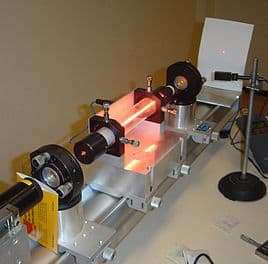Introduction to Laser
Опубликовано: 01.12.2021

Laser:
A laser is basically a device that throws or emits light with the help of the process of optical amplification based on the stimulated emission of electromagnetic radiation. The full form of term “laser” is “light amplification by stimulated emission of radiation». Based on the theoretical work of Charles Hard Townes and Arthur Leonard Shallow, Theodore H. the first laser was carried out by Maiman at Hughes Research Laboratories in 1960.
There is a difference between other sources of light and laser, the difference is that it emits light that is coherent. Spatial coherence helps the laser to focus the light on the tight spot, which makes its application in lithography and laser cutting. Spatial coherence also allows a laser beam to remain narrow over large distances (bump), enabling applications such as laser pointers and lidar. There can be high temporal coherent even in the lasers also which allows them to emit light which has a very narrow spectrum. On the other hand, ultrashort pulses of light can be produced with the help of temporal coherence which have a broad spectrum but durations as short as femtoseconds.
Lasers are used in a wide range of applications including laser printers, DNA sequencing instruments, semiconducting chip manufacturing (photolithography), laser surgery and skin treatments, military, and law enforcement devices for marking targets and measuring range and speed, optical disc devices, barcode sensors, fiber-optic, free-space optical communication, cutting and welding materials, and in laser lighting displays for entertainment. In order to produce custom lasers, fused silica cylindrical lens and high power laser windows are used.
Semiconductor lasers in the blue to near-UV have also been used in place of light-emitting diodes (LEDs) to excite fluorescence as a white light source. This allows for a much smaller emitting area and avoids LEDs suffering from too much glare of a laser; Such a device has already been used in some car headlamps.
Fundamentals:
Because of the presence of coherence, the lasers are considered different from the other light sources. Transverse (or Spatial) coherence is typically expressed through the output being a narrow beam, which is diffraction-limited. Laser beams can be focused to very small spots, receive too much radiation, or deviate too little to focus their power over very short distances. Polarized wave at a single frequency can be produced with the help of Longitudinal (or temporal) coherence, whose phase is correlated over a relatively great distance along the beams.




